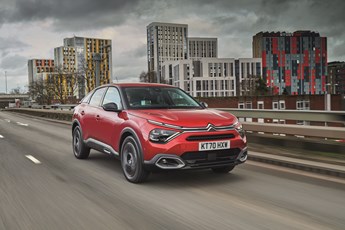
The start point for the best source of fleet information |
Model update: Citroen C4
Date: 13 April 2021 | Author: Simon Harris

|
|
||||||||
Citroën's C4 has had a rollercoaster ride over the years. First introduced in 2004 as a replacement for the Xsara, it wowed TV audiences with its 'Transformers' style marketing campaign.
Then offered as a practical five-door hatch, or three-door coupé, the car appeared avant-garde and hi-tech.
It was toned down for the next-generation, which saw sales fade while the quirky C4 Cactus later effectively became the C4 hatchback.
The strategy deployed for the C4 Cactus - using the cost and weight benefits of a small car platform to produce a medium hatchback - has been used again for the latest C4, which has components and technology in common with the Peugeot 208 and 2008, Vauxhall Corsa and Mokka, and the DS 3 Crossback.
Styling, once again, is idiosyncratic, and Citroën has emphasised this and comfort as key attributes that had been lost in a generation or two of its medium cars.
We encountered left-hand drive versions of the E-C4 and the petrol C4 towards the end of 2020, and we were pleasantly surprised.
Some of the C4 Cactus's flimsiness is replaced with a more solid feel, while some of the sharp angles emphasised in the exterior styling are continued inside.
It looks good, although cabin storage itself is so-so, and, of course, as French car manufacturers resolutely refuse to switch sides for the fuse box when producing right-hand drive models, there isn't much of a glove compartment to speak of.
It perhaps feels a little less spacious inside than a Ford Focus or Volkswagen Golf, but part of that is likely to do with the coupé-like shape. While the boot's 380-litre minimum capacity is decent enough, rear visibility is compromised because of the split rear screen.
In rediscovering its heritage in comfortable cars, Citroën has ensured the cabin environment includes reduced dashboard clutter and welcoming looking seats, as well as Progressive Hydraulic Cushion suspension ironing out the worst imperfections in the road ahead.
The suspension is neither as complex nor high-maintenance as previous hydropneumatic suspension systems on Citroëns, and nor does it deliver quite the same cosseting ride, but it's a good USP for the brand in an era when many marketing campaigns promote the virtues
of handling.
We tried the 1.5-litre diesel, which produced 130hp in our test car, although a 110hp variant will follow.
In 130hp guise it comes with an eight-speed automatic transmission as standard, which, of course, adds cost and might not be to everyone's taste, but it suits the C4's demeanour very well, and the combination of diesel engine and auto is very smooth.
It has lower CO2 emissions than many other diesel-auto rivals, too, which could bump it up a little on user-chooser lists.
Overall costs are quite impressive, not only thanks to its frugal diesel engine, but also pretty solid residual values.
We suspect in these changing times, with the emergence of electrified power becoming more interesting for fleet users, that the diesel will never be as popular as it once was. But the C4 diesel is a fine example of what once was a traditional format for a fleet car, ticking almost all the rational boxes, but with some extra quirkiness thrown in.
Citroën C4 1.5 BlueHDi 130 Shine auto
P11D: £26,825
Residual value: 35.9%
Depreciation: £17,191
Fuel: £5,154
Service, maintenance and repair: £2,088
Cost per mile: 40.7p
Fuel consumption: 61.4mpg
CO2 (BIK %): 119g/km (27%)
BIK 20/40% a month: £121/£241
Luggage capacity: 380 litres
Engine size/power: 1,499cc/130hp
Verdict |
8/10 |
|||
 |
|
 |
|
|










